Icebergs from Above
The previous evening we’d noticed a trail head near our boondocking spot. It was called “Camelback Trail.” The sign had multiple paragraphs of warnings about what to do if you encountered either a moose or coyote.
So after breakfast we climbed the trail. As we rose on Camel Island, we could look down at Griquet Island (rhymes with cricket). In the waterway between the two islands, three small icebergs were mired. These were the same icebergs we’d seen from the restaurant the previous night. How fun to have a birds-eye view of the icebergs. We watched a Zodiac boat scoot between them, knowing we would soon be on that boat.
This experience felt like quintessential Newfoundland, exactly why we love it here. You stop some place you’ve never heard of, wander a bit, and stumble across one of the most beautiful sights you’ve ever seen.
At the top of the mountain was a sign about “Arctic Giants.”
They come, but they don't stay long, and many of them die here. Ninety percent of the icebergs that reach this shore began their journey more than a year ago, calving off one of Greenland's iceberg-producing glaciers. They flow slowly down the cold Labrador Current and along the coast of Newfoundland. This route is called Iceberg Alley for good reason, as many of them get trapped in the bays, coves and bights along the way. So many icebergs run aground and melt here that St. Anthony Bight is known as an iceberg graveyard. The freshwater that flows into the ocean as an iceberg melts is some of the purest water in the world, and froze over 15,000 years ago.
Icebergs may look serene, but fishermen give them a wide berth. They can roll and split without warning, flooding a boat within seconds and tipping its crew into the icy waters. Icebergs also wreck havoc with fishing nets and buoys, to say nothing of oilrigs. When icebergs approach the oil drilling operations off Newfoundland, they are lassoed and towed safely out of range.
Another couple was hiking just ahead of us. We exchanged pleasantries — they were Spanish speaking, from Quebec. Near the top we saw the woman, alone, looking a bit frantic. So we spent some time helping the woman find her husband. It’s easy to lose sight of each other since the trail branches off in multiple directions. A person could simply wander off, agog, as there were gorgeous views in every direction.
At the mountain top we were above tree line, which is one of our favorite ecosystems. These low-growing tundra plants thrive in impossible conditions — strong wind, beating rain, freezing temps. “Life will find a way,” I think to myself. I try not to step on them, but when I do, their springiness underfoot makes my heart happy.
Down among the trees, robins fly about and sing. Two rabbits hop along, and the remains of another was scattered along the trail. A coyote, I suppose. We came across piles of moose poop, including one that was quite fresh. (If you want to see the photo, leave a comment!)
Chatting with a Local Fisherman
We hiked for more than an hour, then returned to Big Blue. As we were packing up to leave, a fellow came over to chat. I asked if he was a fisherman and he said Yes, but not anymore. He’d had a brain tumor that required three operations. He whipped off his cap to show us the scar across his forehead. He said he’d been airlifted to the hospital. For a while he lost his sight.
I asked if he received care in St. John’s. “Yes, from one of the best doctors in the western world, he was from Lebanon.” He’d been told he had only a 10% chance of surviving the surgery. “I just said, ‘Tell me where to sign. I’m not afraid of that none.’”
When he asked where we were from, and Doug said Virginia, the fella pointed to a house across the water. The folks who bought it were from Virginia. I commented that it looked new and he said it was old, they spent a fortune fixing it up. She was a schoolteacher and he was with the Navy.“When I do something nice for them, they put $100 in an envelope and send it to me, I told her they needed to stop that.”
As we were leaving the man gestured to the dock. “If you’da parked further out, I would’a come and told you to move. It’s not safe there, the girders below are all rusted.”
The Zodiac Boat Tour
Our Dark Tickle Boat Tour was scheduled from 1:00 to 3:00. The building was an old shop painted goldenrod, a color you see often here. There were ten of us including the captain. The first order of business was to struggle into one-piece flotation suits, bright orange. We were told to size up, and looked puffy and enormous in the suits. They’re the same ones the Coast Guard uses and provide great protection against windchill, which is significant on the water. The water is only 1 degree Celsius.
The captain’s name was Vary, short for Varrick, last name of Snow. He was probably a bit under 40, the fourth generation to work for the company that runs the tour boats — they used to be fish merchants until the cod fisheries collapsed in 1993.
When we were all aboard the boat, Vary gave us some general history of the people of Newfoundland, beginning with the indigenous people, then the Beothuk, then the Vikings for ten years, then the Norsemen, then the Spanish and Portuguese, who didn’t stay long, and the French and English who did.
The arrival of Europeans decimated the Beothuk with diseases like TB, plus violent encounters. There’s not a single Beothuk alive. (We’ve read other accounts of this black mark on Newfoundland history, I was glad to hear him bring it up.)
Icebergs Up Close
Our Zodiac first visited the three small icebergs we’d just seen from the top of Camel Mountain.
Then we set out to motor a distance to a large iceberg. We’d seen it just the evening before when it was close to shore, but during the night it broke free and drifted far out to sea.
The icebergs are generally anchored to the bottom in 100, or 200, or 300 feet of water. As chunks fall off, making them smaller, and the movement of the tides and wind rocks them, they break free, and off they float.
The water was unusually calm, with no troughs or gullies, just the rhythmic thumping of a boat slapping against the water as it runs at 16 to 18 knots.
The iceberg was taller than a 2-story house, and very irregularly shaped, different from every vantage point. A blue line ran like a lightning rod. Capt. Vary said the blue line was integral to the iceberg itself, part of its formation some 10,000 years ago.
The iceberg’s various shapes cast shadows onto itself, shadows which were deeply blue, made of nothing more than compacted snow. The white of the berg seemed textured, but at other times appeared translucent and almost waxed.
As we all learned from the Titanic, ninety percent of an iceberg is underwater. From above, that underwater mass looks pale green.
The iceberg palette is a symphony of blues — a chunk of white that shades from blue to green, bobbing under an expansive blue sky streaked with clouds, all afloat on a rippling bed of still more shades of blue.
Puffins & Common Murres
A few puffins and common murres flew by, or bobbed in the water. They are small, black birds. The puffins have colorful beaks and feet, while the murres have black beaks, with white bellies that are evident when they dive into the water.
“The other difference between them,” Very told us, “is that we eat the common murres, but we don’t eat puffins.” Later, when asked, he told us that the murres, like all saltwater birds, have to be dipped in hot water before they can be plucked. Then they’re roasted, and the meat is dark and greasy. Some people remove the skin, it’s so oily.
A Digression about the Great Auk
The common murre is a relative of the extinct, and much larger, Great Auk, which the explorers actually lit on fire like a torch, they were so oily. That’s why the Great Auk were hunted to extinction — they were flightless birds, as tall as a toddler, and people were always needing more light.
I imagine people thought it was easy and funny to chase big, awkward birds with useless wings, birds who’d never seen two-legged predators before. Maybe the birds were curious. Maybe they paused for one moment. Before the species had a chance to evolve any kind of defense, they were extinct. Gone. Neither you, nor I, nor anyone will ever see a Great Auk.
A Curious Harp Seal
As we bobbed gently, taking in the iceberg in front of us, an inquisitive harp seal popped up, then swam alongside us. He turned his whiskered face in our direction and moved slowly along the length of our boat, his large eyes taking in the sight of us, such strange creatures.
I’ll give him the last word today.

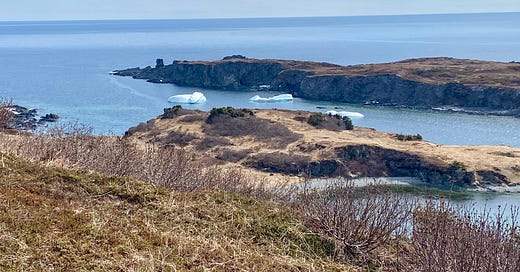



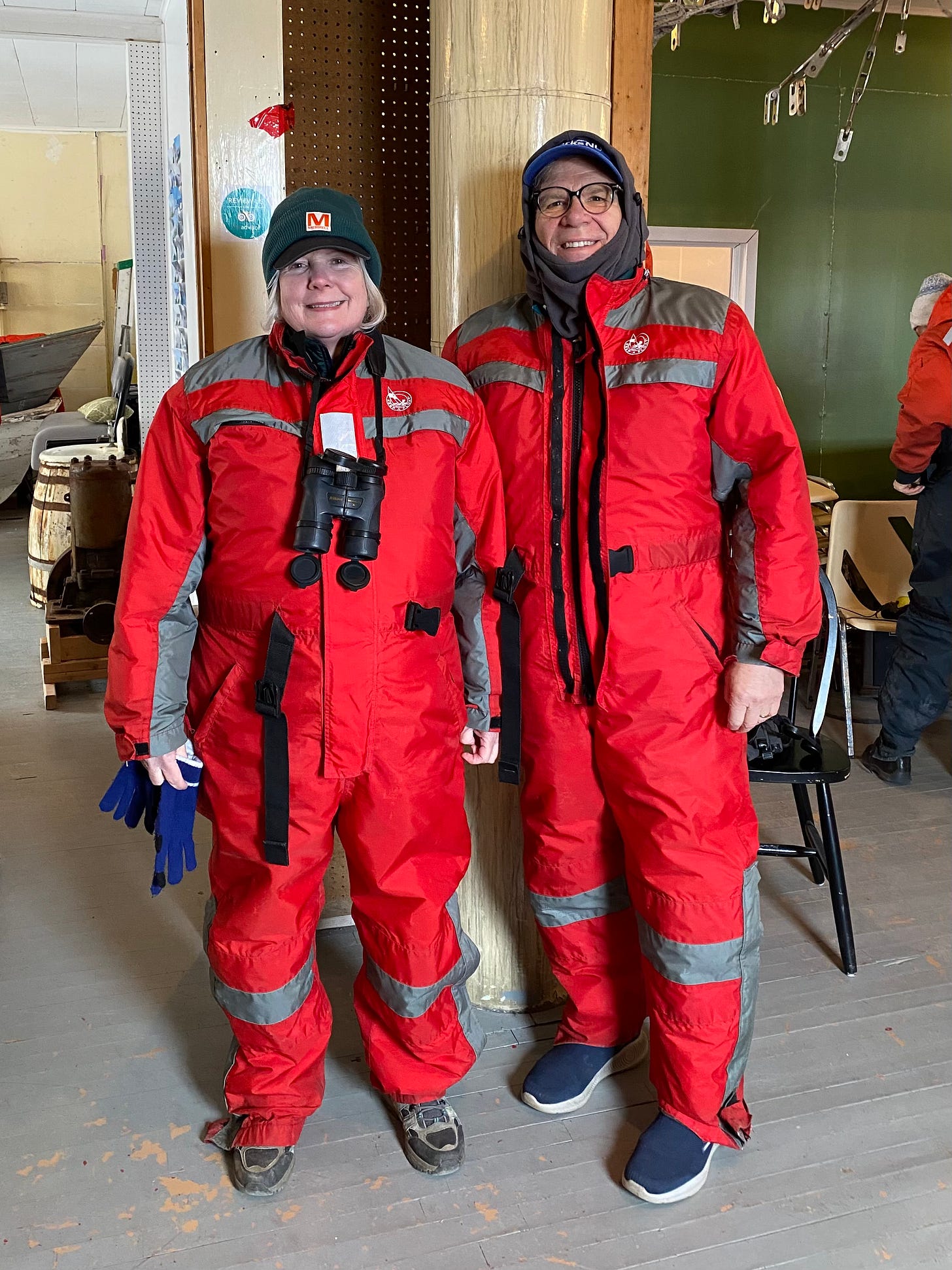
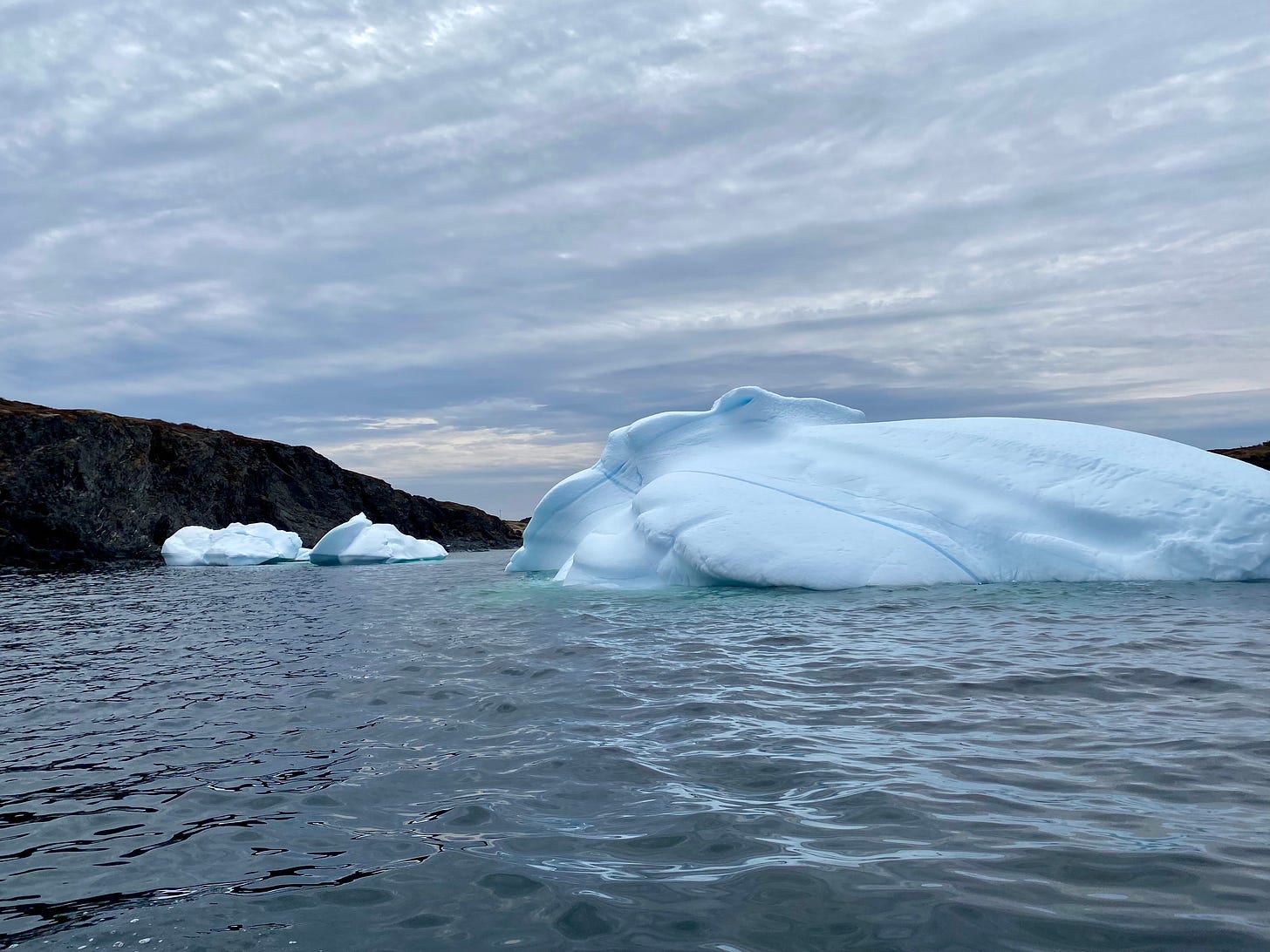
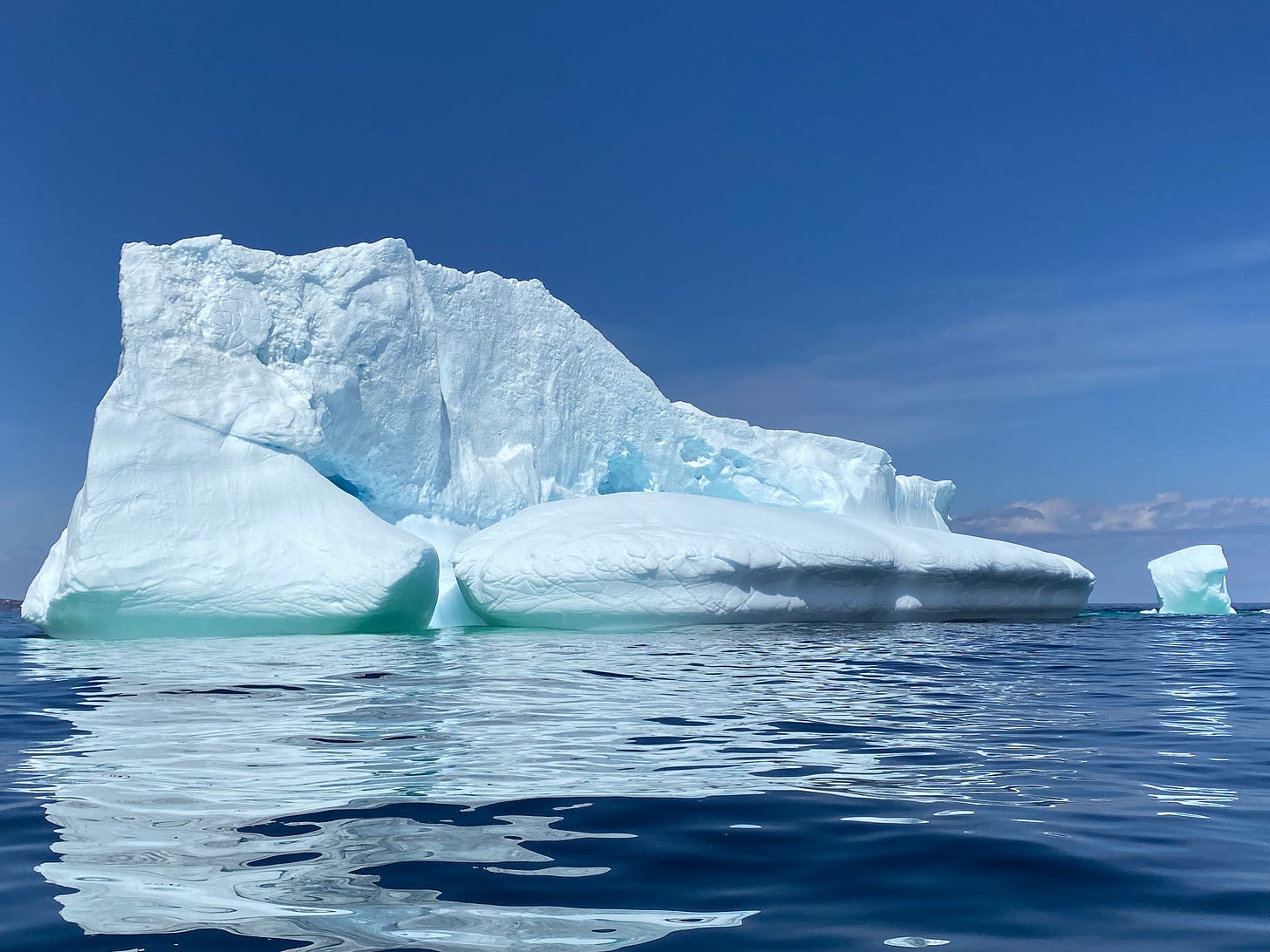

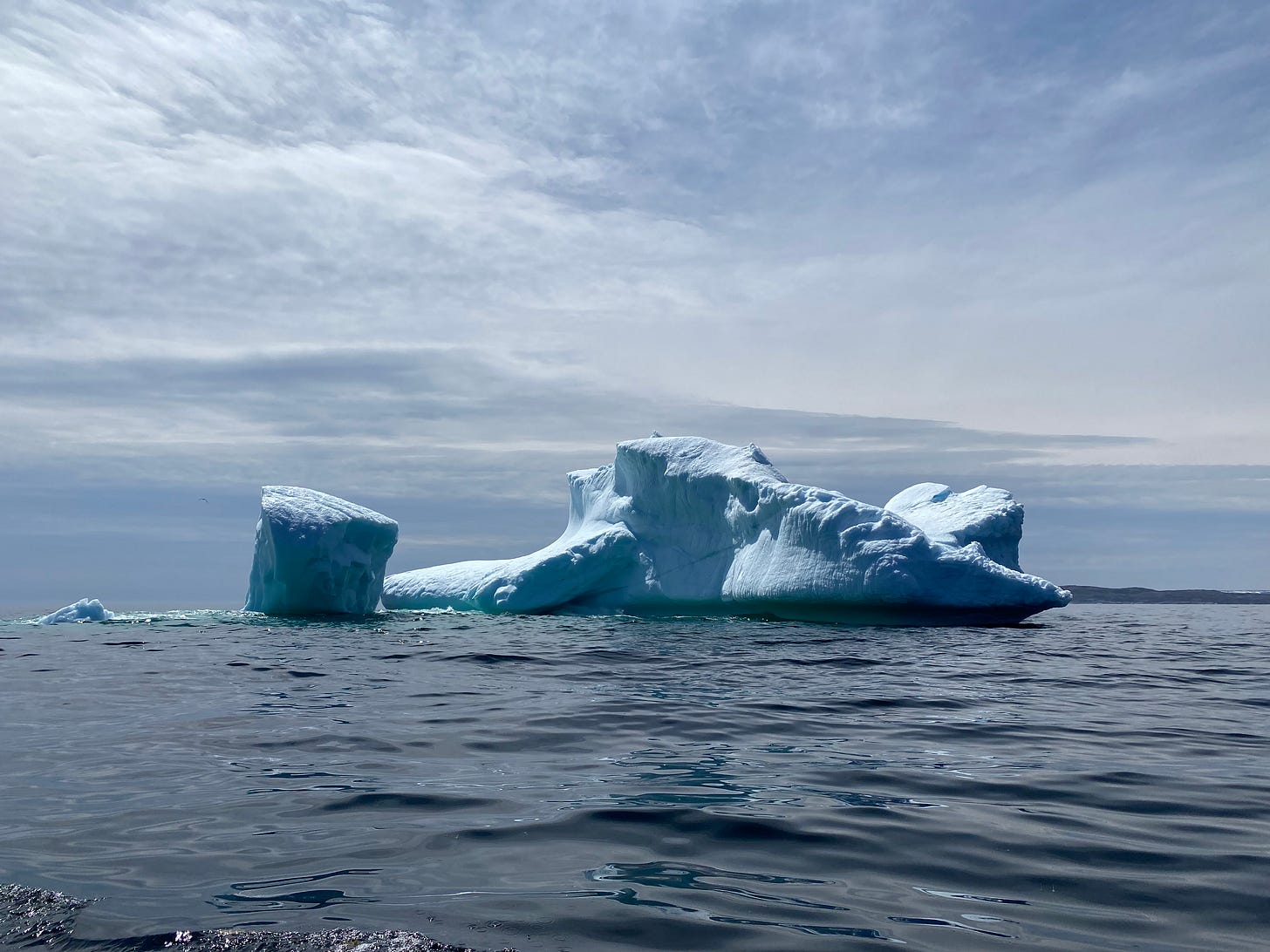
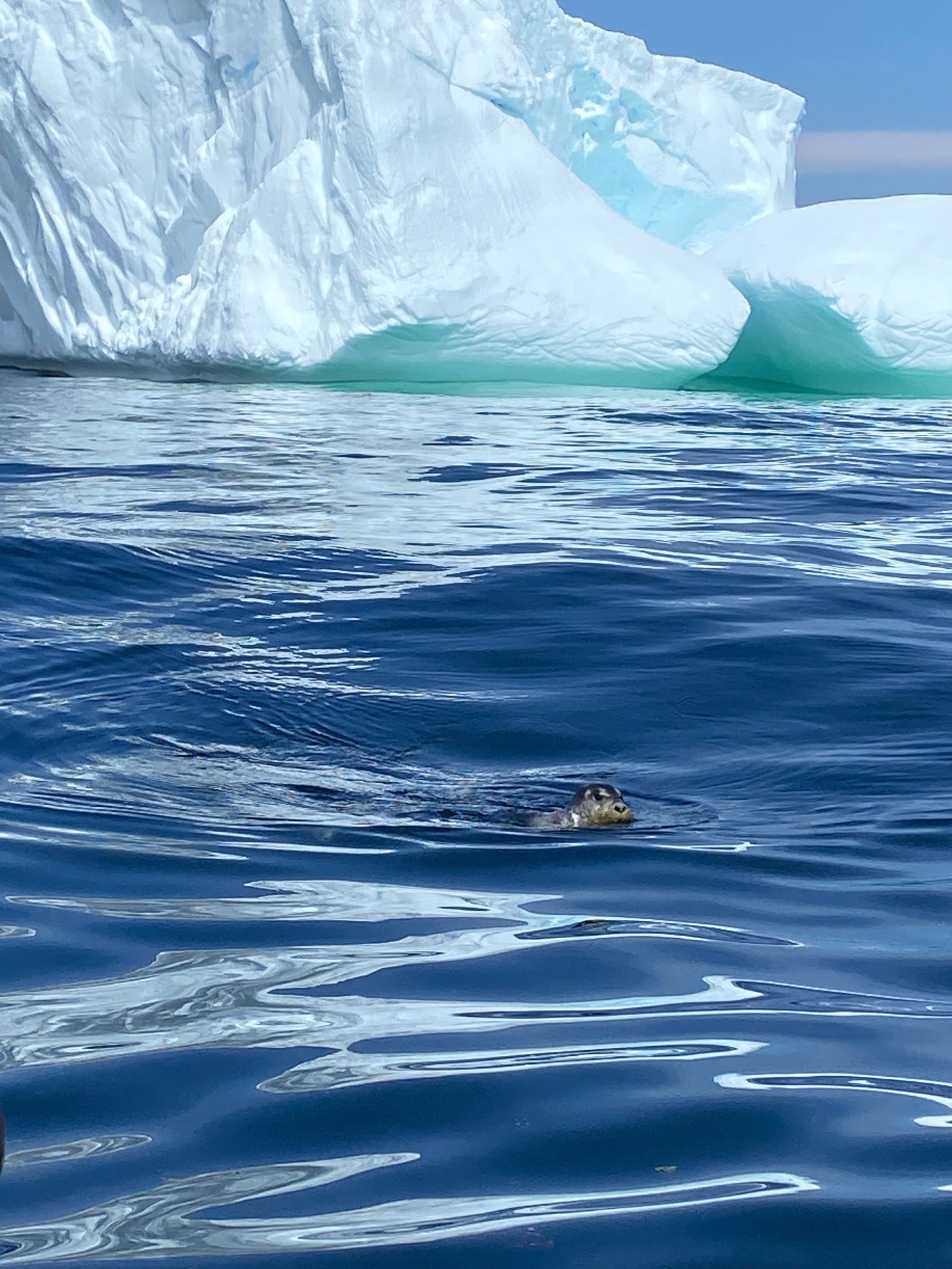
So interesting! Thanks for sharing your adventures!💕
I am enjoying your adventures! We’re heading up there from PA in late July.